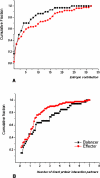Proteomic shifts in embryonic stem cells with gene dose modifications suggest the presence of balancer proteins in protein regulatory networks
- PMID: 18043732
- PMCID: PMC2077926
- DOI: 10.1371/journal.pone.0001218
Proteomic shifts in embryonic stem cells with gene dose modifications suggest the presence of balancer proteins in protein regulatory networks
Abstract
Large numbers of protein expression changes are usually observed in mouse models for neurodegenerative diseases, even when only a single gene was mutated in each case. To study the effect of gene dose alterations on the cellular proteome, we carried out a proteomic investigation on murine embryonic stem cells that either overexpressed individual genes or displayed aneuploidy over a genomic region encompassing 14 genes. The number of variant proteins detected per cell line ranged between 70 and 110, and did not correlate with the number of modified genes. In cell lines with single gene mutations, up and down-regulated proteins were always in balance in comparison to parental cell lines regarding number as well as concentration of differentially expressed proteins. In contrast, dose alteration of 14 genes resulted in an unequal number of up and down-regulated proteins, though the balance was kept at the level of protein concentration. We propose that the observed protein changes might partially be explained by a proteomic network response. Hence, we hypothesize the existence of a class of "balancer" proteins within the proteomic network, defined as proteins that buffer or cushion a system, and thus oppose multiple system disturbances. Through database queries and resilience analysis of the protein interaction network, we found that potential balancer proteins are of high cellular abundance, possess a low number of direct interaction partners, and show great allelic variation. Moreover, balancer proteins contribute more heavily to the network entropy, and thus are of high importance in terms of system resilience. We propose that the "elasticity" of the proteomic regulatory network mediated by balancer proteins may compensate for changes that occur under diseased conditions.
Conflict of interest statement
Figures





Similar articles
-
Pronounced alterations of cellular metabolism and structure due to hyper- or hypo-osmosis.J Proteome Res. 2008 Sep;7(9):3968-83. doi: 10.1021/pr800245x. Epub 2008 Jul 23. J Proteome Res. 2008. PMID: 18646788
-
Cardioinductive network guiding stem cell differentiation revealed by proteomic cartography of tumor necrosis factor alpha-primed endodermal secretome.Stem Cells. 2008 Feb;26(2):387-400. doi: 10.1634/stemcells.2007-0599. Epub 2007 Nov 8. Stem Cells. 2008. PMID: 17991915
-
Quantitative proteomics characterization of a mouse embryonic stem cell model of Down syndrome.Mol Cell Proteomics. 2009 Apr;8(4):585-95. doi: 10.1074/mcp.M800256-MCP200. Epub 2008 Nov 10. Mol Cell Proteomics. 2009. PMID: 19001410 Free PMC article.
-
Proteome alteration of early-stage differentiation of mouse embryonic stem cells into hepatocyte-like cells.Electrophoresis. 2009 May;30(9):1431-40. doi: 10.1002/elps.200800836. Electrophoresis. 2009. PMID: 19424999
-
Flow field-flow fractionation: a pre-analytical method for proteomics.J Proteomics. 2008 Aug 21;71(3):265-76. doi: 10.1016/j.jprot.2008.06.002. Epub 2008 Jun 10. J Proteomics. 2008. PMID: 18602503 Review.
Cited by
-
Genetic Background Specific Hypoxia Resistance in Rat is Correlated with Balanced Activation of a Cross-Chromosomal Genetic Network Centering on Physiological Homeostasis.Front Genet. 2012 Oct 15;3:208. doi: 10.3389/fgene.2012.00208. eCollection 2012. Front Genet. 2012. PMID: 23087704 Free PMC article.
-
Impairment of adolescent hippocampal plasticity in a mouse model for Alzheimer's disease precedes disease phenotype.PLoS One. 2008 Jul 23;3(7):e2759. doi: 10.1371/journal.pone.0002759. PLoS One. 2008. PMID: 18648492 Free PMC article.
-
A large number of protein expression changes occur early in life and precede phenotype onset in a mouse model for huntington disease.Mol Cell Proteomics. 2009 Apr;8(4):720-34. doi: 10.1074/mcp.M800277-MCP200. Epub 2008 Nov 30. Mol Cell Proteomics. 2009. PMID: 19043139 Free PMC article.
-
Recombinase mediated cassette exchange into genomic targets using an adenovirus vector.Nucleic Acids Res. 2010 Jun;38(11):e123. doi: 10.1093/nar/gkq192. Epub 2010 Apr 5. Nucleic Acids Res. 2010. PMID: 20371519 Free PMC article.
-
Establishment of a mouse model with misregulated chromosome condensation due to defective Mcph1 function.PLoS One. 2010 Feb 16;5(2):e9242. doi: 10.1371/journal.pone.0009242. PLoS One. 2010. PMID: 20169082 Free PMC article.
References
-
- Goldberg MS, Fleming SM, Palacino JJ, Cepeda C, Lam HA, et al. Parkin-deficient mice exhibit nigrostriatal deficits but not loss of dopaminergic neurons. J Biol Chem. 2003;278:43628–43635. Epub 42003 Aug 43620. - PubMed
-
- Mangiarini L, Sathasivam K, Seller M, Cozens B, Harper A, et al. Exon 1 of the HD gene with an expanded CAG repeat is sufficient to cause a progressive neurological phenotype in transgenic mice. Cell. 1996;87:493–506. - PubMed
-
- Palacino JJ, Sagi D, Goldberg MS, Krauss S, Motz C, et al. Mitochondrial dysfunction and oxidative damage in parkin-deficient mice. J Biol Chem. 2004;279:18614–18622. - PubMed
-
- Zabel C, Klose J. Influence of Huntington's Disease on the Human and Mouse Proteome. Int Rev Neurobiol. 2004;61:241–283. - PubMed
-
- Periquet M, Corti O, Jacquier S, Brice A. Proteomic analysis of parkin knockout mice: alterations in energy metabolism, protein handling and synaptic function. J Neurochem. 2005;95:1259–1276. Epub 2005 Sep 1257. - PubMed
Publication types
MeSH terms
Substances
LinkOut - more resources
Full Text Sources
Molecular Biology Databases

